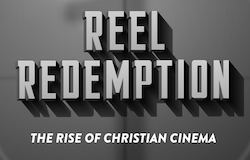The Sacramental Void in Evangelical Film, by Esther O’Reilly
27 Dec
One of the salient features of a particular kind of film marketed explicitly to evangelical Christians is the use of what Tyler Smith calls “the emblem.” Among other characteristics, it typifies what Tyler has classified under the umbrella of “Christian social drama” in his master’s thesis. Examples of this genre include movies like Fireproof, Courageous, War Room, God’s Not Dead, and Do You Believe. The form of the emblem varies from movie to movie, but consistently, there’s some monument or object that represents the characters’ commitment to family and faith.
In Fireproof, the main character is given a marriage manual that he begins to follow religiously and comes to see as a symbol of his desire to reconnect with his wife. In Courageous, the characters draw up a set of resolutions as they challenge each other to be more faithful fathers, which each man frames and hangs on his wall as a constant reminder. In War Room, a young wife is advised to create a prayer closet and cover it with written-out prayer requests as she tries to save her marriage. In God’s Not Dead, the emblem is actually introduced by the villain, as Professor Radisson tells his students to sign a piece of paper saying “God is dead.”
While these emblems aren’t identical to each other, a curiously consistent pattern emerges as we survey them: They’re all distinctly verbal in nature. As a result, the power that they should have in these movies often feels weighed down by a certain clumsiness.
By contrast, consider the iconic visual force of certain familiar emblems in Catholic art: the host, the chalice, the crucifix. When these make an appearance in a novel, a painting, or a film, no words are required. In Brideshead Revisited, a woman is haunted by the memory of a crucifix on her wall and is eventually compelled by guilt to break off an affair. When her lapsed Catholic father is on his deathbed, he consents to receive the Sacrament and makes one final sign of the cross before expiring. In Shusaku Endo’s Silence (now a major motion picture by Martin Scorsese), 17th century Japanese Christians are forced to renounce their faith, not by signing a written contract, but by stepping on the fumie, the face of the dying Christ cast in bronze.
This artistic disparity goes back to a very old schism between two kinds of Christianity: Christianity of the Sacrament and Christianity of the Word. It’s not quite as simplistic as Catholic versus Protestant, as Protestant denominations like Anglicanism and Lutheranism still retain a strongly sacramental oeuvre in principle and practice. (For example, Anglicans and Lutherans, like Catholics, believe in some sort of Real Presence in the administration of communion.) However, certain strains of evangelical Protestantism have historically shied from any kind of iconographic symbolism. In my Baptist hymnal, there’s a line in “Abide With Me” that runs “Hold thou thy Word before my dying eyes.” But this was not the original line. Initially, it read, “Hold thou thy cross before my dying eyes.” It’s clear that whoever compiled this hymnal was uncomfortable with the iconographic nature of such a line, which might even suggest not merely a cross but a crucifix. (Of course, this change hurts rather than helps the lyric. It doesn’t make particular sense to hold up a Bible in front of someone who’s dying, whereas the use of a cross or a crucifix in this way has logical precedent.) To give another example, my own grandmother was very displeased when a cross was added to the top of her church, and the addition wasn’t put to a vote. There was no doubt where her vote would have gone if it had been.
You might notice I left out one of the films mentioned above. That’s because Do You Believe? is the one exception to this pattern. In this film, the emblem isn’t a document, a book, or something else involving the written word. It’s a small wooden cross, distributed en masse by a pastor to his congregation. These crosses take on progressively more symbolic meaning as they are passed on to different people the congregants encounter. In the film’s most affecting scene, a fireman gives his cross to a dying man, closing his hand around it while sharing the gospel. Sure, it’s not a crucifix, but it comes surprisingly close for an evangelical context. Interestingly, an under-the-radar Catholic novelist named Michael O’Brien used a very similar motif in one of his books, where a street woman passes out small icons of the Virgin Mary that are in turn passed along to different characters in crisis. Do You Believe? is the only film of its genre, to my knowledge, that imbues a sacred symbol with something that begins to approach the significance of a relic. As a result, while still typical of much evangelical art in its heavy-handed writing and muddled plotline, it is surprisingly buoyed in several key moments by the visual resonance an image can provide where dialogue fails.
This speaks to a kind of sacramental void in evangelical art. A Catholic friend once quipped that she receives grace weekly, on the tongue. An evangelical Protestant can talk about grace, can write a sermon about grace, but lacks the idea of a tangible, fleshy vehicle of grace. Yes, Baptists and other evangelicals do take Communion, but the physical crackers and juice are carefully stripped of any intrinsic significance, unlike a consecrated host. So, thus deprived of Sacrament, they are left with Word. However, as Do You Believe? shows, the symbolism of the cross still remains as a way for something with sacramental resonance to get a foot in the door.
Of course, even those little wooden crosses are not presented as something to be prayed to, or as objects that can exert some miraculous power in and of themselves. However, people like my grandmother would still be distinctly uncomfortable at the way the fireman says “Here, take this,” pressing the cross into the dying man’s palm. “What does this little piece of wood matter?” she might say. It doesn’t save anyone. The fireman’s verbal presentation of the gospel should be enough. Literally speaking, this would be true. And yet, it would miss the point.




No comments yet